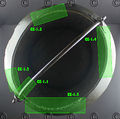CE-1 situla: Difference between revisions
Sindy Kluge (talk | contribs) No edit summary |
Sindy Kluge (talk | contribs) No edit summary |
||
| Line 15: | Line 15: | ||
|inventory_number=6387 | |inventory_number=6387 | ||
|source=Marzatico 1998: 29–30, fig. 9; Oberosler 2004: 645–646, fig. 6.4; Marzatico 2011: 640–641, fig. 7.15 | |source=Marzatico 1998: 29–30, fig. 9; Oberosler 2004: 645–646, fig. 6.4; Marzatico 2011: 640–641, fig. 7.15 | ||
|checklevel= | |checklevel=5 | ||
|problem=detailed object description | |||
}} | }} | ||
==Commentary== | ==Commentary== | ||
The bronze situla of Cembra is also known as “Situla Giovanelli”, named after the first owner, the conte Benedetto Giovanelli.<br>'''Find circumstances''': The situla was found by Simone Nicolodi on the hill of Caslir (Doss Caslyr) in 1825 during the construction of the basement of a building. In occasion of the construction the excavators “si avvennero in una grotticella tutta intorno grossamente murata, e nello scassinarla diedero in esso. Ma il ritrovarono senza alcunché né dentro, né fuori, né d’ossa né di ceneri, né di carboni e semplicemente ripieno, com’ella era anche la grotticella stessa, di fine terra filtratavi per l’opera delle stagioni e di secoli” {{bib|Giovanelli 1844}}: 134).<br>'''Interpretation''': Giovanelli has excluded a domestic function because of the presence of the five inscriptions as well as a funerary context due to the absence of traces of bones or ash. {{bib|LIR}}: 206) | The bronze situla of Cembra is also known as “Situla Giovanelli”, named after the first owner, the conte Benedetto Giovanelli.<br>'''Find circumstances''': The situla was found by Simone Nicolodi on the hill of Caslir (Doss Caslyr) in 1825 during the construction of the basement of a building. In occasion of the construction the excavators “si avvennero in una grotticella tutta intorno grossamente murata, e nello scassinarla diedero in esso. Ma il ritrovarono senza alcunché né dentro, né fuori, né d’ossa né di ceneri, né di carboni e semplicemente ripieno, com’ella era anche la grotticella stessa, di fine terra filtratavi per l’opera delle stagioni e di secoli” {{bib|Giovanelli 1844}}: 134).<br>'''Interpretation''': Giovanelli has excluded a domestic function because of the presence of the five inscriptions as well as a funerary context due to the absence of traces of bones or ash. {{bib|LIR}}: 206) | ||
{{bibliography}} | {{bibliography}} | ||
Revision as of 22:00, 1 February 2015
| Object | |
|---|---|
| Proper name: | Situla di Cembra |
| Classification: | vessel |
| Archaeological type: | Situla |
| Material: | bronze |
| Size: | height 28 cm, widest diam. top 24 cm, widest diam. bottom 23 cm |
| Condition: | complete, damaged |
| Date: | 4th century BC |
| Date derived from: | typology |
|
| |
| Site: | Cembra (Trento, Trentino-Alto Adige, Italy) |
| Field name: | Caslir |
| Coordinates (approx.): | 46° 10' 30.00" N, 11° 13' 19.20" E [from site] |
| Find date: | 1825 |
| Current location: | Castello del Buonconsiglio |
| Inventory Nr.: | 6387 |
|
| |
| Inscriptions: | |
|
| |
| Sources: | Marzatico 1998: 29–30, fig. 9 Oberosler 2004: 645–646, fig. 6.4 Marzatico 2011: 640–641, fig. 7.15 |
Images
|
Object CE-1 situla with inscription CE-1.1 (handle).
|
Object CE-1 situla.
|
Object CE-1 situla - detail.
|
Object CE-1 situla - detail.
|
Commentary
The bronze situla of Cembra is also known as “Situla Giovanelli”, named after the first owner, the conte Benedetto Giovanelli.
Find circumstances: The situla was found by Simone Nicolodi on the hill of Caslir (Doss Caslyr) in 1825 during the construction of the basement of a building. In occasion of the construction the excavators “si avvennero in una grotticella tutta intorno grossamente murata, e nello scassinarla diedero in esso. Ma il ritrovarono senza alcunché né dentro, né fuori, né d’ossa né di ceneri, né di carboni e semplicemente ripieno, com’ella era anche la grotticella stessa, di fine terra filtratavi per l’opera delle stagioni e di secoli” Giovanelli 1844: 134).
Interpretation: Giovanelli has excluded a domestic function because of the presence of the five inscriptions as well as a funerary context due to the absence of traces of bones or ash. LIR: 206)
Bibliography
| Giovanelli 1844 | Benedetto Giovanelli, Dei Rezj. Dell'origini de' popoli d'Italia e d'una iscrizione rezio-etrusca. Pensieri di Benedetto Conte Giovanelli Podestà di Trento, Trento: 1844. |
|---|---|
| LIR | Alberto Mancini, Le Iscrizioni Retiche [= Quaderni del dipartimento di linguistica, Università degli studi di Firenze Studi 8–9], Padova: Unipress 2009–10. (2 volumes) |
| Marzatico 1998 | Franco Marzatico, "Recipienti preromani in lega di rame (bronzo) dal territorio atestino", in: Umberto Raffaelli (Ed.), Rame d'arte. Dalla preistoria al XX secolo nelle Alpi centro-orientali. Catalogo della Mostra tenuta a Trento, Castello del Buonconsiglio, 20 giugno – 8 novembre 1998, Trento: Provincia autonoma di Trento 1998, 13–36. |
| Marzatico 2011 | Franco Marzatico, "Catalogo. Sezione 7. Lungo le vie della scrittura. 7.15. Situla con attacchi a croce antropomorfi ed iscrizione", in: Franco Marzatico, Rupert Gebhard, Paul Gleirscher (Eds), Le grandi vie delle civiltà: relazioni e scambi fra il Mediterraneo e il centro Europa dalla Preistoria alla Romanità: catalogo, Trento: Castello del Buonconsiglio: Monumenti e collezioni provinciali 2011, 640–641. |




